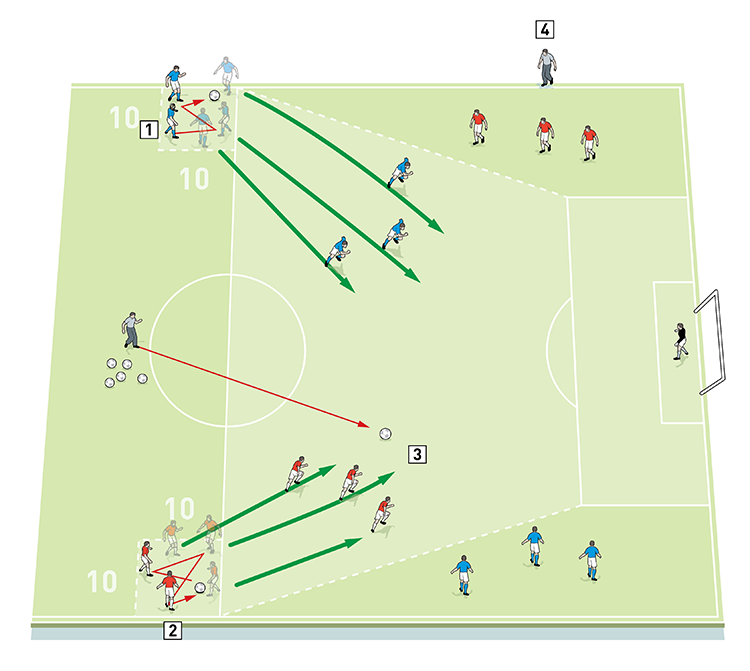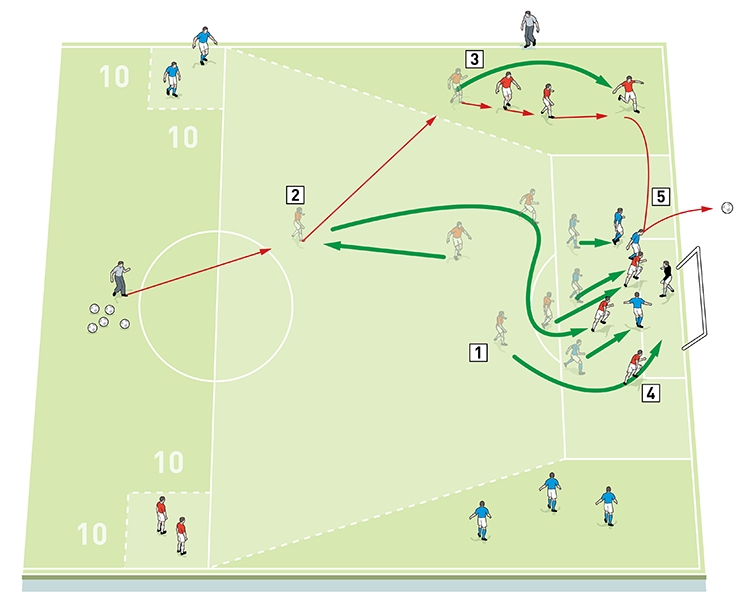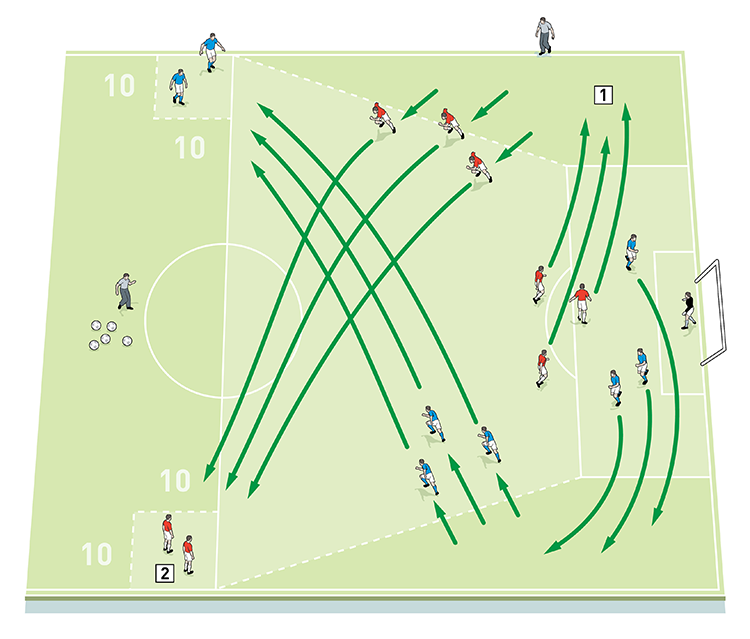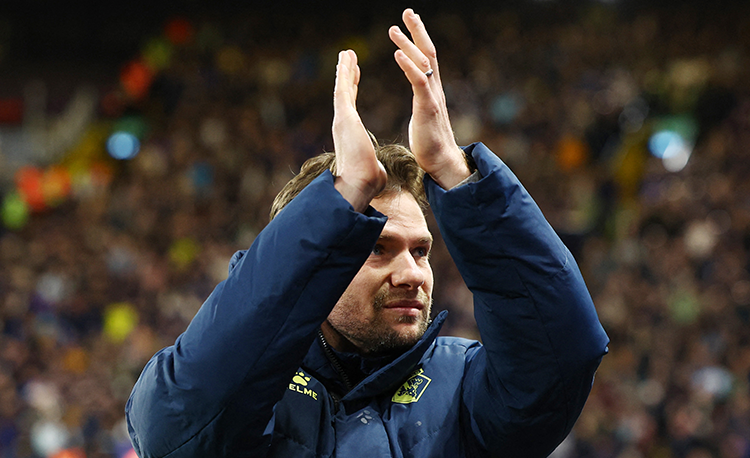Attacking & defending
This session focuses on the techniques of attacking and defending in and around the penalty area, giving players the opportunity to rehearse not only counter-attacking situations, but to attack and defend crosses from deep and from the by-line. It is a high intensity session that involves plenty of running and lots of accelerations and decelerations.

| Area | Three quarters of pitch |
| Equipment | Balls, bibs, cones, 1 full size goal |
| No. of Players | 16 players |
| Session Time | Timings depend on required outcomes |
This session focuses on the techniques of attacking and defending in and around the penalty area, giving players the opportunity to rehearse not only counter-attacking situations, but to attack and defend crosses from deep and from the by-line. It is a high intensity session that involves plenty of running and lots of accelerations and decelerations.
It requires all players to both defend and attack as they would in a game. When out of possession, the players must work as a unit to recover, delay, tackle, block and clear the ball from crosses. When in possession, the players try to create scoring chances and get the opportunity to run with the ball, pass and move, dribble, and make runs off the ball, as well as attack crosses in the penalty area.
This session allows for plenty of repetition, it offers a sense of competition between teams, and it will improve the basics of attacking and defending in situations that replicate the game.
We will often run this in pre-season. The length of the session and the space and intensity will change, depending on the time of the week and the state of the players, but the amount and type of running involved means that it is a good session to get the players match fit.
What do I get the players to do?
Attacking & defending
We set up on three quarters of a pitch with a goal and goalkeeper at one end. A tapered wide zone is coned off on each side, funnelling towards the penalty area, and two 10x10-yard possession boxes are set up just over the halfway line. We’re using 16 outfield players, split into a red attacking team of eight and a blue defending team of eight. Each team starts with five players in its own possession box on the halfway line and three players in its wide zone on the opposite wing to their box.
Both teams begin by passing a ball around in their own possession box using one-touch passing on the move. They pass unopposed until triggered to start the first attack by the coach, who plays a ball from the centre circle into the midfield, as shown [1a]. Three members of the red attacking team break out of their box and race onto the ball, while three blue defenders break out of their box to defend the goal.
1a

2. The reds are the attacking team and they also start with five players one-touch passing around their possession box
3. When the coach passes into the main area, three attackers and three defenders break out to compete for the ball. The aim for the attackers is to score in the goal
4. A coach on the touchline enforces the offside rule
The players attack through the middle of the pitch, either running with the ball, passing and moving, or dribbling, and making runs off the ball to create opportunities to score, as shown [1b]. The defending team try to recover so they are between the ball and the goal and are able to delay the attack.
1b

2. The three blue defenders should recover and try to get themselves between the ball and the goal to delay the attack
When the attack is dead, both teams should reset on the edge of the penalty area, ready to attack (or defend) the goal from a cross. One of the red attackers moves towards the centre circle to receive a second ball from the coach and then plays a pass to his team mates in the wide zone, as shown [1c]. The wide players receive the long diagonal pass and combine, with all three of the wide players touching the ball before one is free to cross into the penalty area, either delivering the ball from deep, or from the by-line, or by pulling the ball back for the attackers to run onto.
1c

2. An attacker drops deep to receive a second ball from the coach and plays a long diagonal pass to a team mate in the wide zone
3. The wide players combine, with all three having to touch the ball before a cross can be delivered into the penalty area
4. The reds make runs to attack the cross. One runs to the front post, one to the back post and the third holds a deeper position on the edge on the penalty area
5. The blue defenders must attempt to block the cross and clear the ball
The attackers should threaten different areas of the penalty box. One runs across the keeper to the front post, another arrives at the back post and the third holds a deeper position on the edge of the box.
For their part, the three defenders should attempt to block the cross and clear the ball out of the area.
When the second attack is dead, the three attackers and the three defenders must switch starting positions with their respective wide players, who sprint from the wide zones back to their possession boxes on the halfway line, as shown [1d]. The two teams then swap roles, with the reds becoming the defenders and the blues becoming the attackers for the subsequent pair of attacks.
1d

2. The wide players for each team sprint to join the two resting players in the possession box and prepare to start the first attack again, with the reds defending this time
How do I progress the session?
As the session develops, we look for improvements in the quality and tempo of the attacking play, and the decisions the defenders make and the effectiveness of the defending.
After this activity, we will progress the session by playing a small-sided game, keeping the same teams. We would expect to see the defending and attacking principles from the session displayed in the game, with the attacking players making runs into the area, attacking crosses and attacking at pace. The defenders should be making recovery runs and clearing the ball.
What are the key things to look for?
The key is to keep the session and the demands on the players as simplistic as possible. The players are then able to focus on the basic principles of attacking and defending in counter-attacking situations, in and around the penalty area. Repeating these basics will build good habits in game situations.
What are the typical mistakes players might make and how do I avoid them?
Players will switch off and misplace passes but the key is to reinforce the basic principles of the session so that they become engrained in the team’s performances.
Editor's Picks
Attacking transitions
Deep runs in the final third
Using the goalkeeper in build-up play
Intensive boxes drill with goals
Penetrating the final third
Creating and finishing
My philosophy
Pressing initiation
Compact team movement
Coaches' Testimonials

Alan Pardew

Arsène Wenger

Brendan Rodgers

Carlos Carvalhal

José Mourinho

Jürgen Klopp

Pep Guardiola

Roy Hodgson

Sir Alex Ferguson

Steven Gerrard
Coaches' Testimonials

Gerald Kearney, Downtown Las Vegas Soccer Club

Paul Butler, Florida, USA

Rick Shields, Springboro, USA

Tony Green, Pierrefonds Titans, Quebec, Canada
Join the world's leading coaches and managers and discover for yourself one of the best kept secrets in coaching. No other training tool on the planet is written or read by the calibre of names you’ll find in Elite Soccer.
In a recent survey 92% of subscribers said Elite Soccer makes them more confident, 89% said it makes them a more effective coach and 91% said it makes them more inspired.
Get Monthly Inspiration
All the latest techniques and approaches
Since 2010 Elite Soccer has given subscribers exclusive insight into the training ground practices of the world’s best coaches. Published in partnership with the League Managers Association we have unparalleled access to the leading lights in the English leagues, as well as a host of international managers.
Elite Soccer exclusively features sessions written by the coaches themselves. There are no observed sessions and no sessions “in the style of”, just first-hand advice delivered direct to you from the coach.









